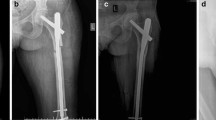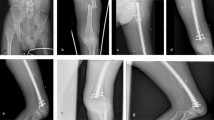Abstract
The timing of definitive fixation for major fractures in polytrauma patients is controversial. We investigated the outcome of the Sheffield hybrid system (SHF) as a solution in the role of primary and definitive fixator for patient with open femoral fractures in whom definitive osteosynthesis with intramedullary nail can be associated with higher rate of complications. Eleven patients (7 men and 4 women), mean age of 40.4 years (range 14–75 years) with previous injury severity score (ISS) greater than or equal to 16 were treated from a damage control orthopedics perspective. Time in the fixator averaged 28 weeks (range 10–64 weeks). Mean follow-up was 3 years (2–4.5). All fractures united. Paley functional and bone results in most cases were good to excellent. Final mean knee range of motion was 113 degrees. We found that SHF for complex fractures of the femur combine maximum support for the bone and preservation of soft tissues. SHF is an effective technique compared to internal nails and earlier external fixator devices, attributable to its advantages such as continuity of frame till union, preventing any second-hit phenomenon, early mobilization, and restoration of primary defect due to bone loss by differential distraction osteogenesis without additional surgery.



Similar content being viewed by others
References
Ali F, Saleh M (2000) Treatment of isolated complex distal femoral fractures by external fixation. Injury 31:139–146
Alonso J, Geissler W, Hughes JL (1989) External fixation of femoral fractures. Indication and limitations. Clin Orthop 241:283–288
Arazi M, Memik R, Ögün TC, Yel M (2001) Ilizarov external fixation for severely comminuted supracondylar and intercondylar fractures of the distal femur. J Bone Joint Surg Br 83:663–667
Catagni MA, Malzev V, Kirienko A (1998) Advances in Ilizarov apparatus assembly, 3rd edn. Il Quadratino, Milano, Italy, pp 42–47
Cavusoglu AT, Ozsoy MH, Dincel VE, Sakaogullari A, Ugurlu M (2009) The use of a low-profile Ilizarov external fixator in the treatment of complex fractures and non-unions of the distal femur. Acta Orthop Belg 75:209–218
Dahl MT, Gulli B, Berg T (1994) Complication of limb lengthening. A learning curve. Clin Orthop Relat Res 301:10–18
Elbatrawy Y, Fayed M (2009) Deformity correction with an external fixator: ease of use and accuracy? Orthopedics 32:82
Farrar M, Yang L, Saleh M (2001) The Sheffield Hybrid Fixator—a clinical and biomechanical review. Injury 32(Supp 4):8–13
Has B, Jovanovic S, Wertheimer B et al (1995) External fixator as a primary and definitive treatment of open limb fractures. Injury 26:4245–4248
Kim NH, Hahn SB, Park HW, Yang IH (1994) The Orthofix external fixator for fractures of long bones. Int Orthop 18:42–46
Lerner A, Fodor L, Soundry M (2006) Is staged external fixation a valuable strategy for war injuries to the limbs? Clin Orthop Relat Res 448:217–224
Moroni A, Vannini F, Mosca M et al (2002) Techniques to avoid pin loosening and infection in external fixation. J Orthop Trauma 16:189–195
Nowotarski PJ, Turen CH, Brumback RJ (2000) Scarboro JM Conversion of external fixation to intramedullary nailing for fractures of the shaft of the femur in multiply injured patients. J Bone Joint Surg Am 82:781–788
Paley D (1990) Problems, obstacles and complications of limb lengthening by the Ilizarov technique. Clin Orthop Relat Res 250:81–104
Paley D, Maar DC (2000) Ilizarov bone transport treatment for tibial defects. J Orthop Trauma 14:76–85
Pape HC, Giannoudis GP, Krettek C (2002) The timing of fracture treatment in polytrauma patients: reverence of damage control orthopedic surgery. Am J Surg 183:622–629
Sala F, Capitani D, Castelli F, La Maida GA, Lovisetti G, Singh S (2010) Alternative fixation method for open femoral fractures from a damage control orthopaedics perspective. Injury 41:161–168
Saleh M (1998) The Sheffield Hybrid Fixator: design considerations and clinical experience. Orthop Prod News; May/June: 33–36
Scalea TM, Boswell SA, Scott JD et al (2000) External fixation as a bridge to intramedullary nailing for patients with multiple injuries and with femur fractures: damage control orthopedics. J Trauma 48:613–623
Scannell BP, Waldrop NE, Sasser HC, Sing RF, Bosse MJ (2010) Skeletal traction versus external fixation in the initial temporization of femoral shaft fractures in severely injured patients. J Trauma 68(3):633–640
Winquist RA, Hansen ST Jr, Clawson DK (1984) Closed intramedullary nailing of femoral fractures. A report of five hundred and twenty cases. J Bone Joint Surgery Am 66:529–539
Zlowodzki M, Prakash JS, Aggarwal NK (2007) External fixation of complex femoral shaft fractures. Int Orthop 31:409–413
Conflict of interest
None of the authors have received financial support related to this study. The current study was approved by Ethical Board Review of Niguarda Hospital (Milan).
Author information
Authors and Affiliations
Corresponding author
Rights and permissions
About this article
Cite this article
Sala, F., Talamonti, T., Agus, M.A. et al. Sequential reconstruction of complex femoral fractures with circular hybrid Sheffield frame in polytrauma patients. Musculoskelet Surg 94, 127–136 (2010). https://doi.org/10.1007/s12306-010-0087-2
Received:
Accepted:
Published:
Issue Date:
DOI: https://doi.org/10.1007/s12306-010-0087-2




